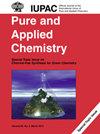可生物降解的热致变色聚乳酸(PLA)传感器
IF 2
4区 化学
Q3 CHEMISTRY, MULTIDISCIPLINARY
引用次数: 0
摘要
本研究通过熔融混合工艺,在聚乳酸(PLA)中加入不同浓度(0、0.5、1、2 和 3 wt%)的热致变色黑色颜料(TCB),对聚乳酸的发展进行了研究。利用比色分析法检测了所得试样在不同温度(-10、10、30、35 和 50 °C)下的颜色转换和还原行为。此外,还分别通过拉伸试验、差示扫描量热仪(DSC)和热重分析(TGA)评估了机械性能、热特性和热稳定性。研究结果表明,TCB 浓度的增加会导致亮度(L*)的降低。颜料含量越高,热致变色特性越强,颜色变化越明显。在五个加热和冷冻周期中,总色差(ΔE)保持可再现性,热老化后这种可再现性依然存在。拉伸强度和断裂伸长率随着颜料含量的增加而提高。热致变色样品的玻璃化转变温度(Tg)和熔化温度(Tm)与纯聚乳酸(64.2 °C)相比降幅很小。结晶度(Xc)略微增加了 0.2-0.92%。热致变色颜料的存在对聚乳酸基体的热稳定性影响很小。本文章由计算机程序翻译,如有差异,请以英文原文为准。
Biodegradable thermochromic polylactic acid (PLA) sensor
This study investigates the development of polylactic acid (PLA) by incorporating thermochromic black pigments (TCB) at varying concentrations of 0, 0.5, 1, 2 and 3 wt% through the process of melt blending. The color transition and reversion behaviors of the resulting specimens were examined at different temperatures (−10, 10, 30, 35 and 50 °C) using colorimetric analysis. Additionally, mechanical properties, thermal characteristic and thermal stability were assessed through tensile testing, differential scanning calorimetry (DSC) and thermogravimetric analysis (TGA), respectively. The study revealed that an increase in TCB concentrations led to a reduction in lightness (L*). Higher pigment content enhanced thermochromic properties, resulting in more pronounced color changes. The total color difference (ΔE) remained reproducible over five cycles of heating and freezing, and this reproducibility persisted after thermal aging. Tensile strength and elongation at break exhibited improvement with increasing pigment content. Glass transition temperature (Tg) and melting temperature (Tm) of the thermochromic samples showed minimal reduction compared to that of neat PLA, which is 64.2 °C. Crystallinity degree (Xc) increased slightly by 0.2–0.92 %. The thermal stability of the PLA matrix was only marginally affected by the presence of thermochromic pigments.
求助全文
通过发布文献求助,成功后即可免费获取论文全文。
去求助
来源期刊

Pure and Applied Chemistry
化学-化学综合
CiteScore
4.00
自引率
0.00%
发文量
60
审稿时长
3-8 weeks
期刊介绍:
Pure and Applied Chemistry is the official monthly Journal of IUPAC, with responsibility for publishing works arising from those international scientific events and projects that are sponsored and undertaken by the Union. The policy is to publish highly topical and credible works at the forefront of all aspects of pure and applied chemistry, and the attendant goal is to promote widespread acceptance of the Journal as an authoritative and indispensable holding in academic and institutional libraries.
 求助内容:
求助内容: 应助结果提醒方式:
应助结果提醒方式:


